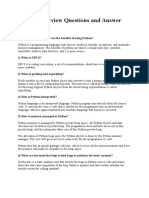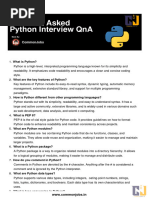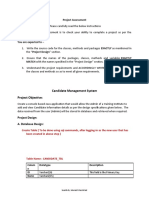0 ratings0% found this document useful (0 votes)
2 viewsPython Advanced
Uploaded by
Abhishek RathoreCopyright
© © All Rights Reserved
We take content rights seriously. If you suspect this is your content, claim it here.
Available Formats
Download as DOCX, PDF, TXT or read online on Scribd
0 ratings0% found this document useful (0 votes)
2 viewsPython Advanced
Uploaded by
Abhishek RathoreCopyright
© © All Rights Reserved
We take content rights seriously. If you suspect this is your content, claim it here.
Available Formats
Download as DOCX, PDF, TXT or read online on Scribd
You are on page 1/ 2
1. What are Python decorators and how do they work?
o Answer: Decorators are a way to modify or extend the
behavior of functions or methods without changing their
actual code. They are defined with
the @decorator_name syntax and wrap another function.
Example:
Python
def my_decorator(func):
def wrapper():
print("Something is happening before the function is called.")
func()
print("Something is happening after the function is called.")
return wrapper
@my_decorator
def say_hello():
print("Hello!")
say_hello()
2. Explain the Global Interpreter Lock (GIL) in Python.
o Answer: The GIL is a mutex that protects access to Python
objects, preventing multiple native threads from executing
Python bytecodes at once. This means that even in multi-
threaded programs, only one thread executes Python code at
a time. It simplifies memory management but can be a
bottleneck in CPU-bound multi-threaded programs.
3. What is the difference between deepcopy and copy in Python?
o Answer: The copy module provides two
functions: copy() and deepcopy(). copy() creates a shallow
copy of an object, meaning it copies the object’s structure but
not the nested objects. deepcopy() creates a deep copy,
meaning it recursively copies all nested objects.
Python
import copy
original = [1, [2, 3], 4]
shallow = copy.copy(original)
deep = copy.deepcopy(original)
4. How do you manage memory in Python?
o Answer: Python uses automatic memory management,
primarily through reference counting and garbage collection.
The gc module provides an interface to the garbage collector,
allowing manual control over the collection process. Memory
management techniques include using weak references and
context managers to ensure resources are properly released.
5. What are metaclasses in Python?
o Answer: Metaclasses are classes of classes that define how
classes behave. A class is an instance of a metaclass.
Metaclasses allow customization of class creation, enabling
advanced features like class decorators and dynamic class
creation. Example:
Python
class Meta(type):
def __new__(cls, name, bases, dct):
print(f"Creating class {name}")
return super().__new__(cls, name, bases, dct)
class MyClass(metaclass=Meta):
pass
You might also like
- 300 Python Interview Questions and Solutions100% (1)300 Python Interview Questions and Solutions88 pages
- Python Interview Questions For Freshers - Docx 1No ratings yetPython Interview Questions For Freshers - Docx 16 pages
- Top 25 Python Programming Viva QuestionsNo ratings yetTop 25 Python Programming Viva Questions4 pages
- IZETAM TECHNOLOGIES - Interview Questions of Python For 2 Years ExperiencedNo ratings yetIZETAM TECHNOLOGIES - Interview Questions of Python For 2 Years Experienced9 pages
- Elaborate All Questions From First to Last on Firs...No ratings yetElaborate All Questions From First to Last on Firs...4 pages
- 1) What Is Python? What Are The Benefits of Using Python?No ratings yet1) What Is Python? What Are The Benefits of Using Python?28 pages
- 100 Most Asked Python Interview QnA PDFNo ratings yet100 Most Asked Python Interview QnA PDF10 pages
- Dokumen - Pub Big Data Concepts Technology and Architecture 9781119701828 1 52No ratings yetDokumen - Pub Big Data Concepts Technology and Architecture 9781119701828 1 5252 pages
- Embedded Systems and IoT - CS3691 - Notes - Unit 2 - Embedded C ProgrammingNo ratings yetEmbedded Systems and IoT - CS3691 - Notes - Unit 2 - Embedded C Programming27 pages
- Outlook Best Practices & How-To's: 1. Follow The Four "DS" When Reading Each MessageNo ratings yetOutlook Best Practices & How-To's: 1. Follow The Four "DS" When Reading Each Message12 pages
- C++ in Open Source Robotics - Jackie Kay, Louise Poubel - CppCon 2015No ratings yetC++ in Open Source Robotics - Jackie Kay, Louise Poubel - CppCon 201552 pages
- Intermediate Financial Management Eugene F. Brigham - Download the ebook now for full and detailed access100% (1)Intermediate Financial Management Eugene F. Brigham - Download the ebook now for full and detailed access65 pages
- Displaying Data From Mutiple Table: JoinsNo ratings yetDisplaying Data From Mutiple Table: Joins9 pages
- Crop Yield Prediction Using Machine LearningNo ratings yetCrop Yield Prediction Using Machine Learning4 pages
- Unoardusimv2.7 Full Help: Code Pane, Preferences, and Edit/ViewNo ratings yetUnoardusimv2.7 Full Help: Code Pane, Preferences, and Edit/View51 pages
- Technical Communication 11th Edition (Ebook PDF) Download PDF100% (2)Technical Communication 11th Edition (Ebook PDF) Download PDF49 pages
- BH US 08 Smith Ames Meta-Post Exploitation PDFNo ratings yetBH US 08 Smith Ames Meta-Post Exploitation PDF69 pages

























































































